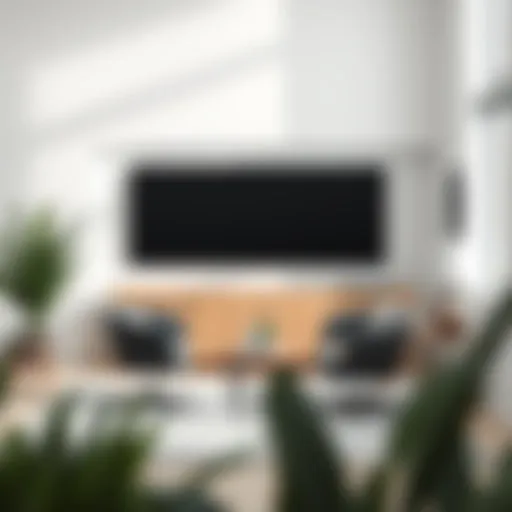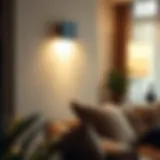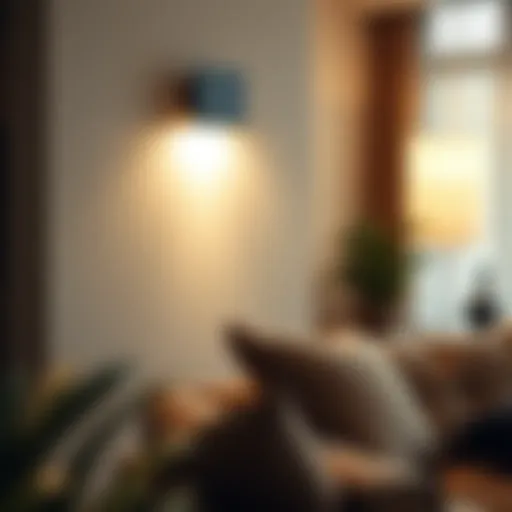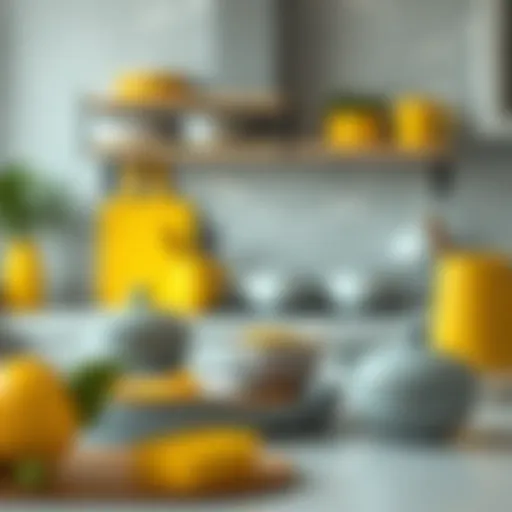Modern Buffet Cabinets: Design and Trends in Focus


Intro
In a world where design meets utility, the modern buffet cabinet has emerged as a pivotal piece of furniture in our homes. This article explores its significance, tracing its evolution to understand how this versatile unit has transitioned from mere storage to a cornerstone of contemporary interior design. It isn't just about aesthetics anymore; it embodies functionality and style, blending seamlessly into various home themes, whether rustic, industrial, or minimalistic. Its journey is one worth examining, as it reveals the changing needs of homeowners and how a simple cabinet can be a game-changer in daily living.
Furniture Styles and Trends
Modern vs. Traditional: Understanding the Aesthetics
When talking about buffet cabinets, the distinction between modern and traditional styles is paramount. Modern buffet cabinets often lean towards sleek lines, minimalistic forms, and the use of innovative materials like metal and glass. They showcase a more open appearance, encouraging a lighter and airy feel in the room. In contrast, traditional buffet cabinets are more ornate, marked by intricate carvings and rich woods that evoke a sense of history and warmth.
Here's a quick comparison:
- Modern Buffet Cabinets
- Traditional Buffet Cabinets
- Minimalistic aesthetic
- Light woods or metals
- Open or modular designs
- Ornate embellishments
- Dark woods like mahogany or oak
- Closed cabinetry with rich finishes
Both styles have their place. The choice often hinges on personal taste and the intended use of the furniture—be it as a dining storage solution or a showcase for decorative items.
Color and Material Trends: What's In and What's Out
Color and material selections for buffet cabinets are continually evolving. Currently, soft, muted tones such as sage green, dusty blue, and warm beige are trending, providing a soothing backdrop that complements various décor styles. On the materials front, reclaimed wood has gained popularity, celebrating sustainability and stories of the past. Additionally, eco-friendly materials are on the rise as homeowners seek options that reflect their values.
Materials to watch:
- Reclaimed Wood
- Metal Accents
- Durable Composites
In contrast, high-gloss finishes and overly bright colors are falling out of favor, signaling a shift towards a more organic and grounded aesthetic. The key takeaway for homeowners and designers alike is to choose materials and colors that not only speak to current trends but also resonate with their personal style.
Furniture Care and Maintenance
Tips for Prolonging the Life of Your Furniture
Regardless of whether your buffet cabinet leans modern or traditional, maintaining its condition is crucial. Regular cleaning using a damp cloth followed by a dry one helps prevent any buildup of dust. For wooden surfaces, applying a wood conditioner can maintain the sheen and prevent cracking.
Other simple maintenance tips include:
- Avoid direct sunlight to prevent fading.
- Keep drink coasters handy to prevent water rings.
- Use drawer liners to protect interiors from scratches.
DIY Repair Hacks for Common Furniture Issues
Every piece of furniture encounters wear and tear over time. Minor scratches on the surface can be easily remedied with a touch of furniture polish. For deeper scratches, a little DIY magic can go a long way. Consider using a walnut rubbed over the scratch. The natural oils will fill in the void and conceal the mark.
If legs are wobbly, tightening screws or adding small furniture pads can provide temporary fixes. For a more permanent solution, wood glue applied to joints can help restore stability.
Remember, a well-maintained buffet cabinet not only enhances your home’s aesthetic but increases its longevity.
"The modern buffet cabinet is as much about style as it is about making a home functional."
To further explore furniture care, websites like Britannica or forums on Reddit can provide valuable insights.
The buffet cabinet is more than just a piece of furniture; it's a testament to the evolution of home aesthetics and practicality, reflecting how our living spaces are shaped by our daily lives.
Intro to the Modern Buffet Cabinet
The modern buffet cabinet may seem like just another piece of furniture on the surface, but its significance in interior design extends far beyond mere aesthetics. This article aims to explore how the buffet cabinet functions not only as a storage solution but also as a display piece that enhances the overall decor of a home. Its versatility makes it a valuable addition to any living space, serving as a bridge between form and function.
In recent years, the buffet cabinet has evolved from traditional styles to more contemporary designs, reflecting changing tastes and lifestyles. This evolution can be seen in both its functionality and its design, adapting to the needs of modern homeowners who seek to combine beauty with practicality. When selecting a buffet cabinet, factors such as size, material, and style should be considered to ensure it complements the existing decor while serving its intended purpose effectively.
Defining the Modern Buffet Cabinet
The term "buffet cabinet" can evoke different images for different people. At its core, it is a piece of furniture usually found in dining or living areas, designed primarily for storage and display. Typically, it's characterized by a wide top surface suitable for serving meals or showcasing decorative items. However, the modern buffet cabinet takes this basic concept and amplifies it, offering a blend of functionality and artistic expression.
This furniture piece can be crafted from various materials, ranging from rich hardwoods to sleek metals, each contributing a unique touch to the room it's in. Depending on the design, it can house anything from dishes and glassware to linens and trinkets, making it an indispensable part of home organization.
Historical Perspectives
To appreciate the modern buffet cabinet fully, one must take a step back in time. Historically, buffet cabinets have their roots in the dining tradition of serving food, a practice that has been around for centuries. In the 18th century, France played a significant role in the evolution of this furniture piece, leading to the creation of elaborate sideboards that were both functional and decorative.
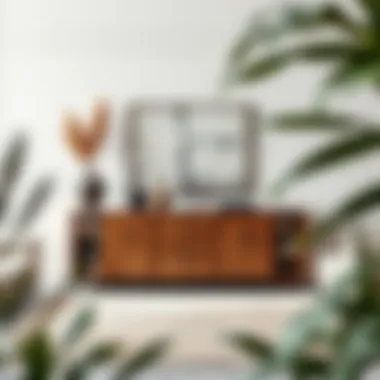
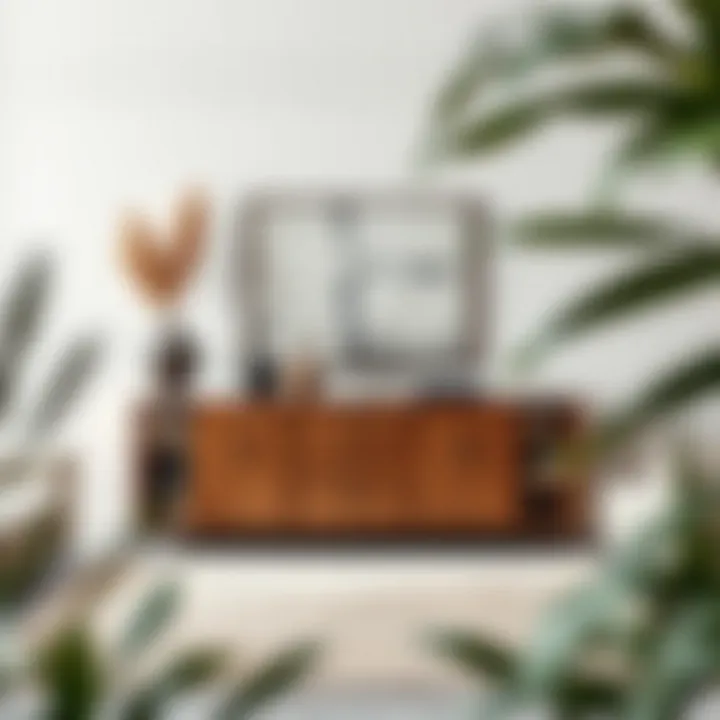
Initially, these cabinets were made from heavy woods with intricate carvings and served a dual purpose: they stored tableware and provided a space for displaying the host’s refined taste. As the centuries rolled on, the design began to evolve. The Industrial Revolution marked a significant turning point, as it enabled mass production of furniture, making buffet cabinets more widely accessible to the general public.
The 20th century saw the emergence of modern design sensibilities that favored cleaner lines and minimalist aesthetics. The buffet cabinet began to reflect these changes, shedding ornate embellishments in favor of sleek forms and practical features, a trend that continues today. As we delve deeper into the facets of the modern buffet cabinet, we will explore its functionality, design trends, materials, and how it fits into various interior settings, enabling homeowners to make informed choices that align with their lifestyle.
Functional Aspects of Buffet Cabinets
In the world of interior design, buffet cabinets emerge as unsung heroes, bringing a harmonious balance between aesthetics and functionality. These versatile pieces serve not just as furniture, but as vital components that enhance the functionality of a space. The significance of understanding the functional aspects of buffet cabinets does not just lie in their ability to provide storage, but also in how they facilitate organization and serve as impactful display areas. Homeowners and designers alike recognize the importance of these pieces in crafting spaces that are both stylish and practical.
Storage Solutions
While the visual appeal of a buffet cabinet can be compelling, it is the storage capabilities that truly define its value. Given the hustle and bustle of modern life, multi-functional storage solutions are in high demand.
Benefits of Multi-functional Storage
Multi-functional storage is the star of the show when it comes to buffet cabinets. This design element offers a clever way to maximize space, allowing homeowners to keep their belongings organized without sacrificing style. A buffet cabinet with integrated shelves, drawers, and compartments can cater to diverse needs—from dining ware to serving platters—ensuring everything finds its place.
One of the key characteristics of multi-functional storage is its adaptability. This makes it not just a beneficial choice but a popular one among those seeking to optimize their living areas. Imagine a sleek buffet cabinet that functions as a bar during gatherings and can easily switch to a display case for cherished family heirlooms. This unique feature promotes versatility and efficiency, making life just a bit easier.
Organizational Features
Moving on to organizational features, these elements are instrumental in transforming chaotic spaces into organized environments. Buffet cabinets often come equipped with a range of compartments or adjustable shelves which help in segmenting items for easy access.
The organizational designs enhance the overall functionality of the space, allowing users to quickly locate what they need without sifting through clutter. This characteristic of organization is exceedingly beneficial, especially for those who may not have the luxury of extensive storage in their homes. It brings a streamlined approach to personal belongings, offering both ease and elegance. However, it’s important to consider that overly complex organizational setups may sometimes overwhelm users, leading to disarray instead of order if not used thoughtfully.
Serving and Display Features
Besides storage, buffet cabinets shine brightly in their serving and display functionalities. Their design often includes expansive tabletops that can adapt to various purposes.
Tabletop Utilization
The utilization of tabletops in a buffet cabinet can be a game changer for entertaining. From serving food during a dinner party to acting as a makeshift bar, the potential of the tabletop is vast. This feature underscores the buffet cabinet's role as a multi-purpose solution—one that is not confined to simply holding items but actively contributes to the hosting experience.
Furthermore, the flat surface allows homeowners to showcase beautiful trays, vintage collections, or stylish serving dishes, elevating the overall decor. However, it’s also worth noting that this space can become cluttered if not managed properly, making it essential for owners to maintain a careful balance between functionality and visual appeal.
Display Space for Decor
On the topic of display space for decor, buffet cabinets can serve as showcase pieces that add character to a room. The design of buffet cabinets often accommodates decor items, such as photos, vases, or art pieces, that reflect the homeowner’s personal style.
This unique feature not only enhances the aesthetic of the space but also allows for personalization. A well-decorated buffet cabinet can act as a focal point in a room, drawing the eye and creating conversation starters. However, one must tread carefully; overcrowding with decor can obscure the functional purpose of the cabinet and create an impression of clutter.
In summary, buffet cabinets bring together functionality and aesthetic value in a balanced manner. Their storage capabilities, coupled with thoughtful designs for serving and display, make them essential furniture pieces that cater to the practical needs of modern living, while also offering a canvas for personal style.
Design Trends in Modern Buffet Cabinets
The design landscape of buffet cabinets is constantly evolving, making it essential for homeowners and designers alike to keep abreast of current trends. Understanding these trends not only enhances aesthetic appeal but also ensures functionality, making buffet cabinets viable central pieces in a variety of interior settings. The trends discussed in this sections reflect shifts in societal values, technological advancements, and the playful blend of styles that characterize our contemporary lifestyles.
Minimalism
Minimalism is much more than a design style; it's a philosophy that embraces simplicity and functionality. In the context of buffet cabinets, minimalistic designs often feature clean lines, neutral colors, and an absence of fuss. This allows the cabinet to blend seamlessly with any decor while maintaining a sophisticated presence.
For example, think of a sleek white buffet cabinet with subtle brass handles. It's not just about its appearance; it's about making a statement through a less-is-more approach. Such cabinets embody an uncluttered aesthetic, which can be particularly appealing in smaller spaces.
The benefits of a minimalistic buffet cabinet extend beyond aesthetic considerations. These pieces tend to be versatile, enabling homeowners to use them for various functions without the overwhelming clutter that ornate designs might introduce. Having a piece that communicates elegance through simplicity often showcases personal style without shouting.
Eclectic Styles
Eclectic styles embrace variety and uniqueness, representing a fusion of different design elements. Buffet cabinets exhibiting an eclectic flair often combine divergent materials, colors, and designs, allowing owners to express their individuality. Picture a cabinet with reclaimed wood juxtaposed against metal accents, or one featuring vintage hardware on a modern frame.
This trend encourages creativity in selection, inviting homeowners to craft a more personalized space. It's not uncommon to find a vibrant-patterned cabinet in a room filled with neutral tones, creating a striking contrast that draws the eye.
Moreover, eclectic buffet cabinets resonate with the global marketplace’s influence. Each piece often tells a unique story, making it more than just a piece of furniture; it turns into a conversation starter, engaging visitors with its rich narrative.
Sustainable Materials
The increasing awareness surrounding environmental issues has led to a rising demand for buffet cabinets crafted from sustainable materials. This trend encompasses the use of responsibly sourced wood, recycled metals, and eco-friendly finishes.
For instance, consider a buffet cabinet made from reclaimed barn wood. Not only do these pieces reflect a commitment to sustainability, but they also bring a rustic charm and historical significance to home decor. Other options, like bamboo, are not only durable but also naturally sustainable, allowing homeowners to decorate with the planet in mind.
Incorporating sustainable materials tells a broader story about consumer choices and environmental responsibility, encouraging the audience to think about the impact of their purchases on the world.
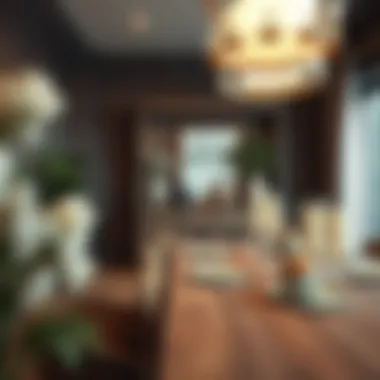
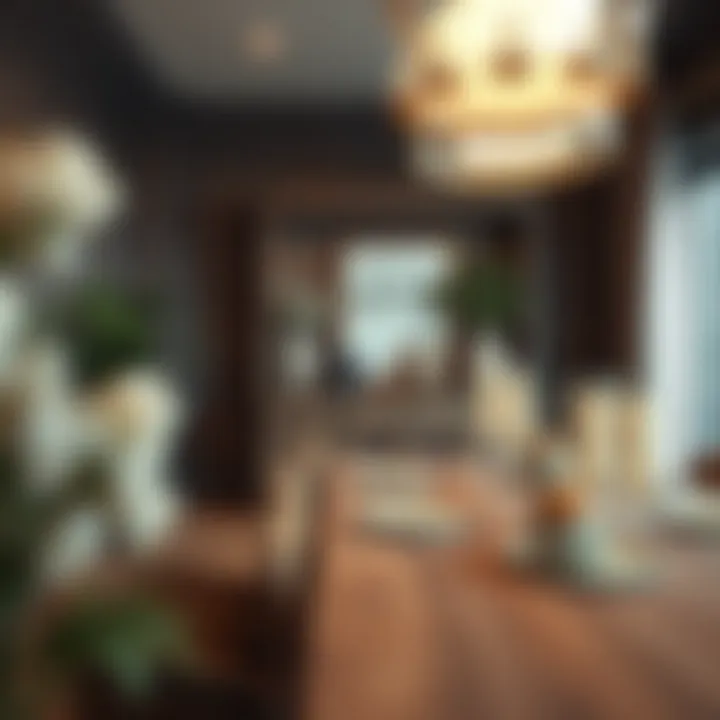
Bold Color Choices
Finally, we witness a spirited re-emergence of bold colors in buffet cabinet designs. Gone are the days of solely neutral palettes. Today, many homeowners opt for vibrant hues like emerald greens, royal blues, or even fiery reds as a way to create visual interest within their dining areas or living rooms.
Imagine a bright coral buffet against soft cream walls; the contrast provides dynamism and warmth, becoming an instant focal point. The use of bold colors allows consumers to express their personality while invigorating their space.
Moreover, this trend easily translates into seasonal changes. A simple change of decor can transform the ambiance, making it feel fresh without the need for complete overhauls.
"Design trends reflect our collective desires, fusing style with function while allowing individual expression to shine through."
Overall, as we reflect on these design trends, it is evident that modern buffet cabinets offer a canvas for creativity, practicality, and sustainability, ultimately enriching the domestic experience.
Materials Used in Modern Buffet Cabinets
When embarking on the journey of selecting a buffet cabinet, the materials employed in its construction play a pivotal role in both aesthetics and practicality. In modern design, the balance between artistry and utility defines the modern buffet cabinet. Homeowners, designers, and even DIY enthusiasts often seek the most fitting materials that not just look good but also stand the test of time.
Choosing the right material can significantly impact the look and feel of a room. Each type brings with it distinct properties, advantages, and considerations that are important to weigh before making a purchase. This section demystifies the primary materials used in contemporary buffet cabinets, emphasizing their importance and unique benefits.
Traditional Wood Options
Wood has always been a cornerstone in furniture design. When one thinks of a buffet cabinet, the image of sturdy, elegant wooden cabinets often springs to mind. Traditional wooden options remain popular due to their warmth and timeless appeal. Mahogany, oak, and walnut are common choices, offering a rich palette of colors and textures.
- Aesthetic Qualities: Wood has a natural grain that creates unique patterns, making each piece one-of-a-kind. This can add an element of sophistication to dining rooms or other areas where buffet cabinets are utilized.
- Durability: High-quality wooden cabinets can withstand years of use, developing a character with age. However, it’s key to choose hardwood varieties for longevity.
- Versatility in Design: Wood can be finished or stained in various ways, allowing it to adapt to various design schemes, whether it be modern rustic or classic elegance.
Contemporary Metal Accents
On the flip side, metal accents have emerged as a striking feature in modern buffet design. Stainless steel, brass, and even blackened metals can offer a refreshing contrast to traditional materials. This juxtaposition can indeed elevate the overall aesthetic.
- Industrial Appeal: Metal brings a sleek, modern feel that complements minimalist or industrial interiors. It can add a touch of sophistication and understated luxury.
- Maintenance: Unlike wood, metal surfaces are often easier to clean and maintain, making them practical for everyday use.
- Design Flexibility: Metal can be formed into various shapes and finishes, offering designers and homeowners a plethora of options when personalizing their buffet cabinets.
Innovative Composite Materials
The rise of technology has ushered in the use of composite materials in buffet cabinet design. Engineered woods, laminate finishes, and recycled materials present homeowners with choices that can be as stylish as they are sustainable.
- Sustainability: Many composite materials are crafted from recycled products, making them an eco-friendly option. This aligns well with the growing trend toward sustainability in home design.
- Affordability: Composite options tend to be more budget-friendly, offering a stylish look without the hefty price tag typically associated with solid wood.
- Versatility: These materials can mimic the appearance of natural woods or even stone, presenting a variety of design possibilities without compromising on style.
Ultimately, the choice of material for a buffet cabinet should align with the homeowner's lifestyle, design preferences, and the intended use of the furniture.
Buffet Cabinets in Various Interior Settings
The buffet cabinet has become a versatile piece of furniture in modern homes, bridging functionality and style. This section uncovers how these cabinets adapt across different settings, ultimately enhancing both utility and aesthetics. From living rooms to dining areas and home offices, buffet cabinets offer unique benefits that cater to the individual needs of each space. Understanding their potential can help homeowners make informed decisions about integration, maximizing their home’s overall design and function.
Living Room Integration
In the living room, the buffet cabinet plays a dual role, enhancing decor while providing unexpected storage solutions. More than just a surface to display family pictures or decorative items, it can cleverly hide away books, electronics, or games. The design options here are broad; for instance, a sleek mid-century modern buffet can complement a minimalist setup, while a rustic wooden piece might warm up a contemporary space.
- Multi-functionality: Buffets can serve as media consoles, housing entertainment systems without cluttering the room. This permits a more cohesive look while ensuring all necessary items are within reach.
- Personal Touch: A well-chosen cabinet reflects the homeowner's tastes, whether it’s painted in a bold hue or showcasing a natural wood grain. This personalization helps the piece stand out as a conversation starter, while also blending in with the overall theme.
Dining Room Dynamics
When it comes to dining areas, buffet cabinets shine as stars of both functionality and elegance. They not only serve as a stylish display for fine china and glassware but also create additional surface area for serving meals. Their existence doesn’t just stop at aesthetics; they encourage organized dining spaces, making every meal feel more structured.
- Serve and Store: A buffet can be laden with platters during gatherings or utilized as a bar for cocktail parties, effortlessly shifting roles between casual family dinners and festive celebrations.
- Seamless Accessories: Integrating coordinating decor items, such as a matching set of serving trays or decorative bowls on the buffet surface, further ties together the dining experience, adding charm and cohesion to the overall design.
Home Office Utility
As remote work becomes increasingly popular, incorporating buffet cabinets into home offices provides clever storage while maintaining an air of professionalism. Often overlooked, these cabinets can serve as stylish file storage or even a compact work surface. This adaptability contributes to an inviting atmosphere that balances productivity with comfort.
- Office Organization: By using drawer space for paperwork and the countertop for office supplies, a buffet cabinet can keep an office organized and free of distraction. Such strategic use of space leads to increased efficiency and a tidy workspace.
- Stylish Representation: Choosing a buffet that resonates with the decor of the office room ensures that the workspace also reflects personal taste. A richly stained wood cabinet could contrast beautifully with lighter-colored office furniture, providing an eye-catching focal point in the room.
A well-placed buffet cabinet brings extra dimension and practicality to your home, proving its true worth across various living scenarios.
In summary, buffet cabinets adapt seamlessly to different interior settings, enhancing overall functionality and style. By considering their thoughtful integration into living rooms, dining rooms, and office spaces, homeowners can ensure their choice of buffet enriches their living environment and meets practical needs.
Choosing the Right Buffet Cabinet
Selecting the ideal buffet cabinet isn't just about finding a piece of furniture that fills a gap. It's a crucial decision that can influence the overall ambiance of your space and address specific functional needs. Identifying the right buffet cabinet means delving into aspects such as space considerations, your personal style, and the inherent functionality each piece can provide.
The buffet cabinet serves multiple roles; it's not just a place to store tableware or display decorative items. With the right choice, it harmonizes with your home décor while maximizing practical usage. Homeowners, designers, and DIY enthusiasts alike must carefully evaluate several factors when settling on one that fits their unique lifestyle and aesthetic preferences.
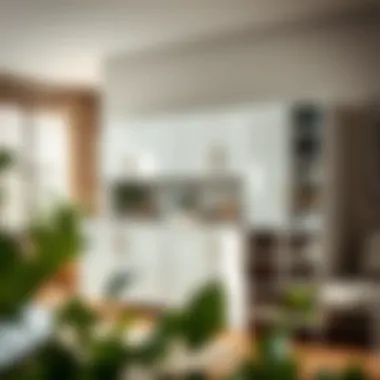
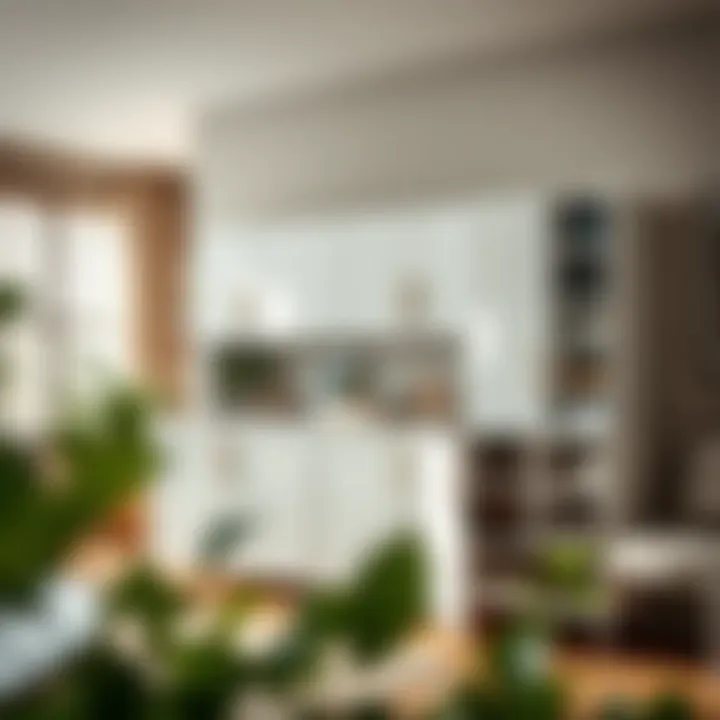
Assessing Space and Size
The first step in choosing a buffet cabinet should be assessing the dimensions of the intended space. It's vital to measure the area where the cabinet will go, as this ensures that the piece does not overcrowd the room. Considerations such as doorway access must also be factored in to avoid positioning a laminate cabinet like an awkward afterthought.
When contemplating size, it's helpful to think about:
- The scale of your room: A tiny buffet in a vast space may seem out of place, while a massive piece in a cozy area can suffocate the environment.
- Your storage needs: How much space you require for items will dictate the cabinet size and the configuration of shelves or drawers.
- The visual impact: Decide whether you want the cabinet to be a subtle addition or a statement piece that grabs attention.
Incorporating a buffet cabinet, when done right, can tie the room together while enhancing functionality. Making sure it fits well within its environment is the foundation of effective choice.
Matching Style with Decor
Once you've settled on the appropriate size, the next hurdle is ensuring that the buffet cabinet complements your existing décor. Different styles evoke various emotions and sentiments, affecting how you (and your guests) experience your space. Here, you might encounter various styles ranging from traditional to modern, rustic to industrial; it can even encompass eclectic themes that blend diverse motifs.
When matching the buffet cabinet with your decor, consider the following:
- Color Palette: Choose shades that either blend seamlessly with or provide a striking contrast to existing hues. A rich mahogany cabinet might beautifully anchor a room with lighter tones.
- Material Consistency: Ensure that the materials used in the buffet match, or harmonize with, other furnishings in the area. Mixing metals or wood finishes requires a delicate touch to prevent a look that screams chaos.
- Design Elements: Pay attention to design details—such as hardware and finish. A buffet cabinet with vintage brass knobs might resonate well in a classic setting but may look out of place in a sleek, minimalist home.
Ultimately, selecting the right buffet cabinet is about making informed choices based on space, size, and style. The right fit can enhance both the practicality of your home and its overall aesthetic. Striking this balance can transform a simple cabinet into a central piece of your living experience.
Care and Maintenance of Buffet Cabinets
The careful nurture of buffet cabinets is crucial for preserving their aesthetic charm and functional integrity. Homeowners often invest significantly in these pieces, both financially and in terms of their interior design vision. Therefore, understanding how to care for and maintain them is not just a routine task—it's a significant step towards ensuring their longevity and continued appeal in your living space.
Considering the diverse range of materials and finishes used in buffet cabinets—such as solid wood, metal accents, or even composite materials—each type necessitates tailored care techniques. One might say that treating your buffet cabinet right is akin to giving it a good cup of coffee in the morning; it sets the tone for the day, or in this case, the years ahead.
Cleaning Techniques for Different Materials
Cleaning a buffet cabinet isn't a one-size-fits-all process. Here are a few tips to consider based on material types:
- Wood: For wooden cabinets, a simple mix of mild soap and water usually does the trick. Always use a soft cloth to prevent scratching the surface. Many folks swear by a mix of vinegar and olive oil for a polished finish, giving that warm glow that makes wood so inviting.
- Metal: For buffet cabinets with metal components, glass cleaner works wonders. Just make sure not to apply too much pressure, as some metals can scratch easily. Wiping down with a microfiber cloth is also good practice, keeping fingerprints and tarnish at bay.
- Glass: For those showcasing fine china, glass shelves or doors may require specialized glass cleaning solutions. Regular window cleaner, paired with a soft, lint-free cloth, can help keep the visibility clear.
- Composite Materials: These require specific cleaners based on the composite composition. Rather than using harsh chemicals, opt for a damp cloth. Over time, you want to make sure that the finish of the cabinet doesn’t degrade, as can happen from aggressive cleaners.
"A little care can go a long way, ensuring that your buffet cabinet remains a functional and stunning part of your home for years to come."
Preventive Care Strategies
Prevention is often better than cure, and this rings absolutely true for buffet cabinet care. Having a few strategies up your sleeve can save you considerable headache later on. Here’s what you can do:
- Positioning: Make sure your buffet cabinet isn’t placed in direct sunlight. Prolonged exposure can fade the finish or cause wooden parts to warp over time. Moreover, avoiding humid areas protects the wood from swelling and cracking.
- Regular Dusting: A quick dusting every couple of weeks will not only keep your buffet cabinet looking fresh but will also help prevent dust build-up that can lead to scratches if left unattended. Using a soft, slightly damp cloth often yields the best results.
- Use Coasters and Mats: If you’re using your buffet cabinet as a serving area, consider placing coasters under drinks and mats under dishes. This shields the surface from potential moisture damage and heat fluctuations that can arise from hot dishes, which might lead to discoloration.
The Future of Buffet Cabinets
As we step further into the contemporary era, the buffet cabinet is not merely a relic from the past, but rather a dynamic piece that adapts to the changing needs and styles of modern homes. Examining the future of buffet cabinets reveals their potential to enhance both functionality and aesthetics in our living spaces. This section sheds light on the significance of integrating technology and new design trends, making buffet cabinets more relevant than ever.
Technology Integration
The role of technology in furniture design has grown massively in recent years, and buffet cabinets are no exception. Smart home integration is at the forefront of this evolution. Picture a buffet cabinet equipped with features like built-in wireless charging stations, customizable LED lighting, or even smart temperature control for the compartment housing wine. These enhancements not only increase practicality but also foster a synergy between traditional furniture and modern conveniences.
Imagine a scenario where you open your buffet cabinet to find a touchscreen interface displaying your wine collection’s optimal serving temperatures. Thaat kind of feature transforms your cabinetry from a simple storage solution to an innovative element of your kitchen or dining room. As homeowners increasingly seek convenience, functionality, and design that reflects their lifestyle, the power of technology will shape the future of buffet cabinets.
Evolving Design Trends
The future of buffet cabinets is closely linked to evolving design trends that embrace diversity and personalization. Gone are the days when a single style ruled the roost. Now, homeowners crave items that tell a story and resonate with their individuality. The buffet cabinet reflects these shifting sensibilities through the embrace of innovative forms, materials, and finishes.
- Multi-functional Designs: Expect to see buffet cabinets that serve dual purposes—like a unit that can transform into a bar cart during gatherings or one that features a fold-out table for extra dining space.
- A Return to Vintage: There is a noticeable resurgence of vintage and retro designs in modern buffet cabinets. These pieces often incorporate mixed materials, combining wood with metal or glass for a timeless appeal.
- Bold and Eclectic Choices: Homeowners increasingly dabble into eclectic aesthetics, embracing colors and patterns that transform these cabinets into statement pieces rather than mere objects of storage.
"In the world of decor, the only constant is change. Buffet cabinets of tomorrow will not merely serve functional needs, they will express who we are."
A look toward the future of buffet cabinets unveils a fascinating interaction between technological advancement and adaptive design. The focus on sustainability and personalization means that manufacturers will continue innovating to meet market demands, ultimately leading to a buffet cabinet landscape that is as diverse and unique as the people who use them. As trends evolve, these cabinets will continue to blend seamlessly into urban lifestyles, ensuring that they play a pivotal role in modern living.
The End
The conclusion serves as the final compass that guides the reader through the wealth of information presented about the modern buffet cabinet. In a time when home design reflects personal style more than mere functionality, a buffet cabinet stands as a vital piece in the overall tapestry of interior decor. Its roles extend beyond storing dinnerware; it reflects choices in aesthetics, materiality, and innovative design elements that resonate with contemporary living.
Recap of Key Points
A trip down our earlier discussions highlights significant insights:
- Versatility: Buffet cabinets serve multiple functions, from storage to display, enriching the usability of various spaces in the home.
- Design Trends: We've observed a movement toward minimalism and eclectic styles, alongside a focus on sustainable materials and vibrant colors, making buffet cabinets a focal point in any room.
- Materials Matter: Attention was also given to traditional woods, contemporary metals, and innovative composites that shape the modern buffet’s character.
- Integration in Spaces: These cabinets can seamlessly fit into living rooms, dining areas, and even home offices, enhancing both aesthetics and organization.
"A well-selected buffet cabinet is more than just furniture; it's a statement piece that harmonizes your living space."
Final Thoughts on Selection and Integration
When choosing a buffet cabinet, consider style alignment with existing decor, alongside practical needs like storage capacity. Balance is key—pick one that resonates with your taste while fitting cohesively within the room's layout. Embrace the opportunity to express individuality through your selection, whether it be a striking piece or an understated classic.
In today’s design landscape, a buffet cabinet is no longer just a mere afterthought; it’s a reflection of personal style and a practical asset in managing everyday life. Homeowners, designers, and DIY enthusiasts alike should see these cabinets as a chance to meld function with flair, ensuring that every piece contributes to a welcoming and organized environment.





